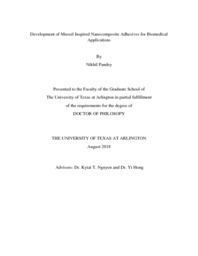
ATTENTION: The works hosted here are being migrated to a new repository that will consolidate resources, improve discoverability, and better show UTA's research impact on the global community. We will update authors as the migration progresses. Please see MavMatrix for more information.
Show simple item record
| dc.contributor.advisor | Nguyen, Kytai Truong | |
| dc.contributor.advisor | Hong, Yi | |
| dc.contributor.advisor | Tang, Liping | |
| dc.creator | Pandey, Nikhil | |
| dc.date.accessioned | 2023-09-11T14:49:51Z | |
| dc.date.available | 2023-09-11T14:49:51Z | |
| dc.date.created | 2018-08 | |
| dc.date.submitted | August 2018 | |
| dc.identifier.uri | http://hdl.handle.net/10106/31666 | |
| dc.description.abstract | Popular bioadhesives, such as fibrin, cyanoacrylate and albumin–glutaraldehyde-based materials, have been applied for clinical applications in wound healing, drug delivery, and bone and soft tissue engineering; however, their performances are limited by weak adhesion strength and rapid degradation. The long-term goal of this research is to develop a strong tissue adhering nanocomposite for tissue interfacing and wound healing applications. We begin by developing a mussel-inspired, nanocomposite–based, biodegradable tissue adhesive by blending poly (lactic-co-glycolic acid) (PLGA) or N-hydroxysuccinimide modified PLGA nanoparticles (PLGA-NHS) and polydopamine nanoparticles with mussel-inspired polymers. Adhesive strength measurement of the nanocomposites on porcine skin-muscle constructs revealed that the incorporation of nanoparticles significantly enhanced the tissue adhesive strength compared to the mussel-inspired adhesive alone. To further optimize this nanocomposite system, we studied the effects of nanoparticle sizes, concentrations and types as well as types of hydrogel materials including alginate and hyaluronic acid-based materials on the tissue adhesive strengths of the nanocomposites. The nanocomposites made from alginate-based polymers were degradable and cytocompatible in vitro and elicited in vivo minimal inflammatory responses in a rat model, suggesting clinical potential of these nanocomposites as bioadhesives. The Hyaluronic acid-based polymers were found to have the best tissue adhesion at 40% w/v polymer concentration. In addition, among the tested nanoparticles (PLGA, PLGA-NHS, Silica and Polydopamine), the developed polydopamine nanoparticles at 200 nm size and 12.5 % w/v concentrations were found be the most effective in enhancing the adhesion of mussel inspired hydrogels (Alginate-dopamine and Hyaluronic acid-dopamine) with adhesive strengths increasing with further increase in nanoparticle concentrations up to 40 % w/v in the nanocomposite blends of Hyaluronic acid-dopamine polymers. Finally, we developed this optimal nanocomposite adhesive into an antimicrobial tissue adhering degradable system and demonstrate its antimicrobial effectiveness on E. Coli and S. Aureus species of bacteria with potential applications of this nanocomposite for healing of chronic wounds. | |
| dc.format.mimetype | application/pdf | |
| dc.language.iso | en_US | |
| dc.subject | bioadhesives | |
| dc.subject | nanoparticles | |
| dc.subject | nanocomposites | |
| dc.subject | tissue interfaces | |
| dc.subject | tissue adhesion | |
| dc.subject | antimicrobial delivery | |
| dc.title | Development of Mussel Inspired Nanocomposite Adhesives for Biomedical Applications | |
| dc.type | Thesis | |
| dc.date.updated | 2023-09-11T14:49:51Z | |
| thesis.degree.department | Bioengineering | |
| thesis.degree.grantor | The University of Texas at Arlington | |
| thesis.degree.level | Doctoral | |
| thesis.degree.name | Doctor of Philosophy in Biomedical Engineering | |
| dc.type.material | text | |
| dc.creator.orcid | 0000-0002-6560-6893 | |
Files in this item
- Name:
- PANDEY-DISSERTATION-2018.pdf
- Size:
- 8.303Mb
- Format:
- PDF
This item appears in the following Collection(s)
Show simple item record


